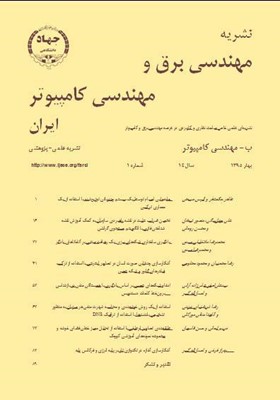ارائه یک الگوریتم توازن بار نامتمرکز در محیطهای ناهمگن
محورهای موضوعی : مهندسی برق و کامپیوترسمیرا حورعلی 1 * , شهرام جمالی 2 , فاطمه حورعلی 3
1 - دانشگاه غیر انتفاعی- غیر دولتی شاهرود
2 - دانشگاه محقق اردبیلی
3 - دانشگاه صنعتی اسفراین
کلید واژه: تکنیک فازی روش پرومته ماشین مجازی محاسبات ابری موازنه بار,
چکیده مقاله :
یکی از راهکارهای اساسی برای ارتقای کارایی در محیط ابر، موازنه بار میباشد. انتخاب VM مناسب برای انجام هر کار، تابع پارامترهای مختلفی مانند میزان منابع مورد نیاز کار نظیر CPU، حافظه، حجم منابع در اختیارVM ها، هزینه و سررسیدVM ها میباشد. در این مقاله با در نظر گرفتن تکتک این معیارها و اهداف طراحی مانند توازن بار، کاهش نرخ ایجاد VM جدید و مهاجرت VM ها، مسأله را در قالب پارامترهای مؤثر در کارایی مدل کرده و سپس مدل فوق را با استفاده از روش پرومته که یکی از پرکاربردترین روشهای تصمیمگیری چندشاخصه است، حل میکنیم. در این روش انتخاب بهترین VM بر اساس ارزش اختصاصیافته به هر یک از معیارها صورت میگیرد که بر اساس منطق فازی تعیین میشود. جهت بررسی کارایی این روش، شبیهسازیهای گستردهای در محیط CloudSim صورت گرفته که نشان میدهد روش پیشنهادی نسبت به روشهای موجود مانند FIFO، DLB و WRR از نقطه نظرات زمان پاسخ، نرخ موفقیت کارها، انحراف بار و نرخ مهاجرت VMها عملکرد بسیار بهتری دارد.
One of the key strategies to improve the efficiency is load balancing. Choosing the appropriate VM to do any task, is function of various parameters such as the amount of required resources like CPU, memory, the size of VM resource, cost and maturity of VMs. In this paper, by considering each of these criteria and design objectives such as load balancing, reducing the rate of create new VM, and VM migration, we modeling the problem in terms of effective parameters in performance. Then, we solving this model by using the PROMETHEE method, which is one of the most widely used method for MADM problems. In this method, selecting the best VM occurs based on the value assigned to each of criteria which is calculated based on fuzzy logic. To evaluate the performance of this approach, the necessary simulations have been carried out on CloudSim simulator and shown that the proposed method has better performance compared to FIFO, DLB and WRR methods on average in terms of response time, rate of success tasks, load variation and rate of VM migration.
[1] B. Rajkumar, C. Yeoa, and S. Venugopala, "Market oriented cloud computing: vision, hype, and reality for delivering IT services as computing utilities," in Proc. 10th IEEE Int. Conf. on High Performance Computing and Communications, pp. 5-13, Sep. 2008.
[2] L. M. Vaquero, L. R. Merino, J. Caceres, and M. Lindner, "A break in the clouds: towards a cloud definition," ACM SIGCOMM Computer Communication Review, vol. 39, no. 1, pp. 50-55, Jan. 2009.
[3] K. Sunny and K. Shivani, "Analysis of different scheduling algorithms under cloud computing," International J. of Computer Science and Information Technologies, vol. 5, no. 2, pp. 2592-2595, 2012.
[4] R. Armstrong, D. Hensgen, and T. Kidd, "The relative performance of various mapping algorithms is independent of sizable variances in run-time predictions," in Proc, 7th IEEE Heterogeneous Computing Workshop, pp. 79-87, Mar. 2012.
[5] M. Maheswaran, S. Ali, H. J. Siegel, D. Hensgen, and R. Freund, "Dynamic matching and scheduling of a class of independent tasks onto heterogeneous computing systems," in Proc. of the 8th Heterogeneous Computing Workshop, HCW'99, p. 30, Apr. 2011.
[6] P. Varalakshmi, A. Ramaswamy, A. Balasubramanian, and P. Vijay Kumar, "An optimal workflow based scheduling and resource allocation in cloud," Advances in Computing and Communications, vol. 190, pp. 411-420, 2011.
[7] L. F. Bittencourt and E. Madeira, "A cost optimization algorithm for workflow scheduling in hybrid clouds," J. of Internet Services and Applications, vol. 2, no. 3, pp. 207-227, Dec. 2011.
[8] A. Zomaya and Y. H. Teh, "Observations on using genetic algorithms for dynamic load-balancing," IEEE Trans. on Parallel and Distributed Systems, vol. 12, no. 9, pp. 899-912, Sep. 2001.
[9] M. Zaharia, D. Borthakur, J. Sarma, and K. Elmeleegy, "Delay scheduling: a simple technique for achieving locality and fairness in cluster scheduling," in Proc. of 5th European Conf. on Computer Systems, EUROSYS'10, pp. 265-278, Paris, France, 13-16 Apr. 2010.
[10] B. Yagoubi and Y. Slimani, "Dynamic load balancing strategy for grid computing," WASET International Journal of Computer, Electrical, Automation, Control and Information Engineering, vol. 2, no. 7, pp. 260-265, ???. 2008.
[11] P. P. Bonissone and K. S. Decker, "Selecting uncertainly calculi and granularity: an experiment in trading off precision and complexity," Kanal and Lemmer, Eds., Uncertainty in Artificial Intelligence, Amsterdam: North Holland: Elsevier Science, 1986, pp. 217-247,
[12] P. P. Bonissone, "A fuzzy set based linguistic approach: theory and applications," in Approximate Reasoning in Decision Analysis. Gupta, MM and Sanchez (Eds), North-Holland: 1982, pp. 329-339.
[13] م. ج. اصغرپور، تصمیمگیریهای چندمعیاره، انتشارات دانشگاه تهران، چاپ دهم، 1390.
[14] A. Sulistio and R. Buyya, "A grid simulation infrastructure supporting advance reservation," in Proc. of the 16th Int. Conf. on Parallel and Distributed Computing Systems, 7 pp., Nov. 2004.
[15] C. Dumitrescu and I. Foster, "Gangsim: a simulator for grid scheduling studies," in Proc. of the IEEE Int. Symp. on Cluster Computing and the Grid, CCGrid'05, vol. 2, pp. 1151-1158, May. 2005.
[16] B. Yagoubi and Y. Slimani, "Task load balancing strategy for grid computing," J. of Computer Science, vol. 3, no. 3, pp. 186-194, Apr. 2012.
[17] A. Revar, M. Andhariya, D. Sutariya, and M. Bhavsar, "Load balancing in grid environment using machine learning-innovative approach," International J. of Computer Applications, vol. 8, no. 10, pp. 975-8887, Oct. 2010.
[18] M. Randles, A. Taleb-Bendiab, and D. Lamb, "Scalable self governance using service communities as ambient," in Proc. of the IEEE Workshop on Software and Services Maintenance and Management, SSMM'09 within the 4th IEEE Congress on Services, IEEE SERVICES-I, pp. 813-820, Los Angeles, CA, USA, 6-10 Jul. 2009.

